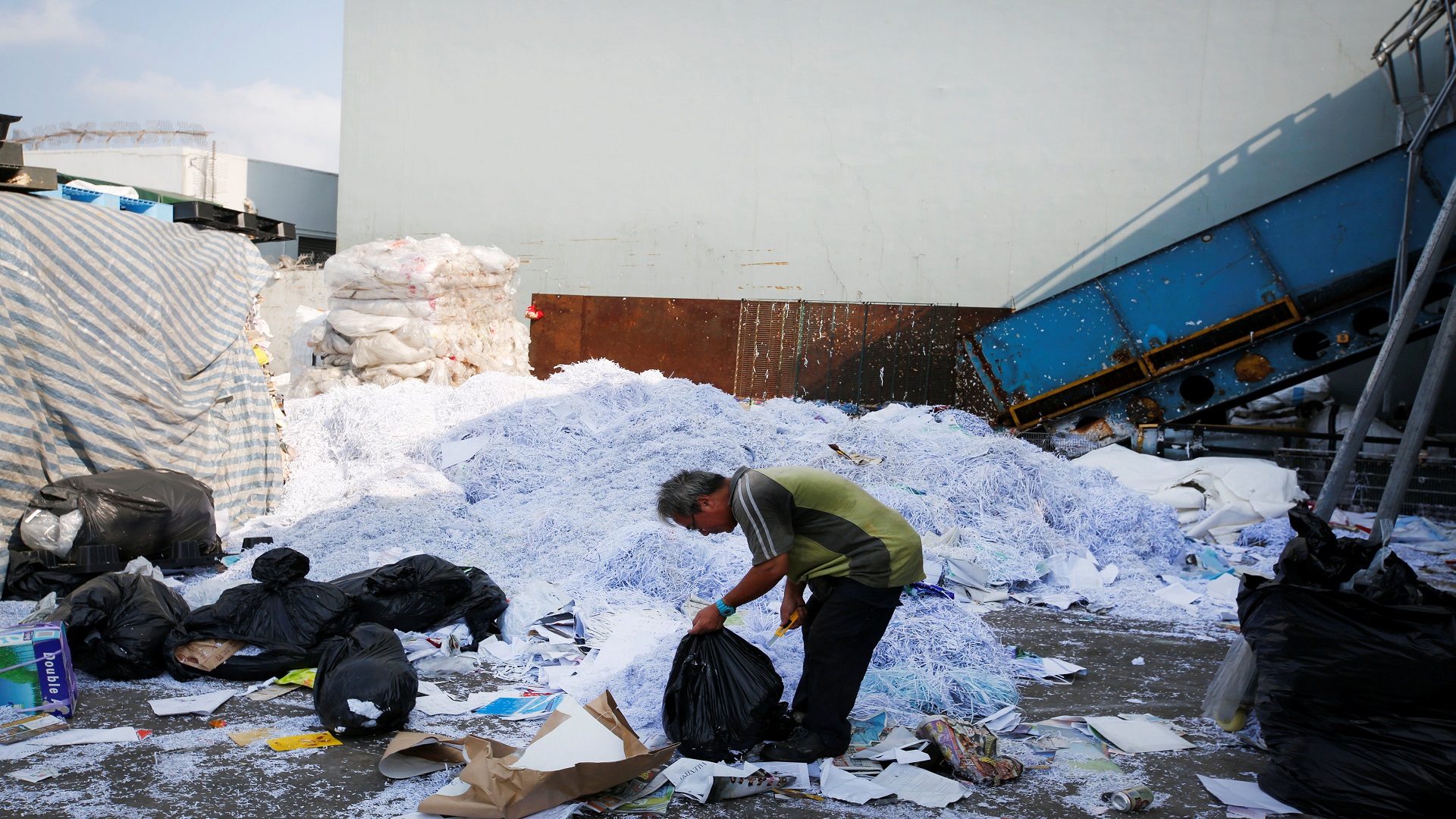Image: A worker picks rubbish from waste paper to be shipped to mainland China at a factory in Hong Kong, China September 19, 2017. REUTERS/Bobby Yip

By Pak Yiu
HONG KONG (Reuters) – Huge mountains of old newspapers, cardboard and office scrap paper are piling up on Hong Kong’s docks and its waste-paper collection sites are at bursting point. A flotilla of cargo ships laden with paper meant for recycling has been stuck for weeks in local waters.
The city’s system for dealing with its paper waste has been failing since China in July imposed a ban on imports of 24 types of rubbish, as part of a campaign against “foreign garbage” and environmental pollution, including unsorted scrap paper.
Each day in Hong Kong, 2,500 tons of fresh paper waste is piling up with no place to go, according to Jacky Lau, director of Hong Kong’s main recycling business association.
“We started our business 50 years ago and we have never experienced such a crisis,” Lau said, saying the industry was losing HK$2.7 million ($346,000) daily.
Traditional suppliers of waste paper to China include Europe, the U.S., Hong Kong, Japan and Southeast Asia, according to industry associations.
While China indicates it will impose an outright ban on mixed waste paper, a final decision isn’t expected until November. For now, authorities have tightened requirements on waste paper to markedly cut back on allowed levels of contaminants, making it difficult for many recyclers to meet.
PAPER PRICE SURGE
As a result of the impasse, the manager of a major paper mill in southern China told Reuters the price of finished paper had doubled to 6,000 yuan ($902) per ton from 3,000 yuan as supplies of the raw material shrink.
That is hurting everyone from e-commerce sites to exporters.
Alibaba’s upcoming “Singles’ Day online shopping festival on November 11, which posted more than 120 billion yuan ($18.1 billion) in sales last year, is heavily reliant on such packaging.
The U.K.’s Environmental Services Association said the restrictions would ripple beyond China.
“Online retailers like Amazon still need cardboard boxes and most comes from China,” said Jakob Rindegren, the recycling policy adviser of the U.K. association.
One corrugated box retailer on the online shopping site Taobao reached by Reuters, said the price of cardboard boxes had nearly doubled since the end of August to 8.8 yuan ($1.33) each.
Thirty-one billion packages were delivered in China in 2016, according to another online retailer JD.com in a statement. The company said it was seeking to markedly cut back on cardboard usage on environmental grounds.
Alibaba didn’t immediately respond with a comment.
The bans, which also include other forms of waste material – plastic, tires and glass – have also had a wider impact on waste shipments to China.
Maersk Line, the world’s largest shipper of containers, said it has already seen a drop in waste cargo into China.
“While it’s too early to understand the full impact, we do see an impact on volumes of waste imports into China. However we expect some measure of rebound as exporters adapt to the new regulations,” said a Maersk spokeswoman in Hong Kong.
Maersk declined to give further details on its China waste shipments.
In a customer notice on Sept. 26 German container shipper Hapag-Lloyd, the world’s fifth largest container line, said it would stop accepting cargoes of scrap plastic and waste paper from Europe, the U.S. and Asia that are due to arrive at Chinese ports after Dec. 31. Hapag-Lloyd did not immediately respond to a request for comment.
ELDERLY PAPER COLLECTORS
For now, as Hong Kong’s paper mountains grow daily, many of the city’s invariably elderly paper collectors say they’ve seen a vital source of income halve in some cases, with many recyclers no longer accepting scrap as the uncertainty lingers.
“There’s not much more I can do if I don’t have enough income,” said an old lady in her 80s lugging a cart stacked with cardboard in the gritty Sham Shui Po district.
“I just have to save here and there to be able to pay my rent … It’s very tough,” said the lady who gave her name as Lam Por Por (Granny Lam).
China, the world’s largest paper recycler, produced some 63.3 million tons of waste paper pulp in 2016, according to the China Paper Association (CPA), with some 24 percent produced from imported waste paper.
Cheung Yan, the chairperson of Nine Dragons Paper Holdings, one of China’s largest packaging and paper producers, said at a recent press conference that the price of recycled paper “wouldn’t be cheap” in the long term.
She didn’t give specifics except to say labor costs had also risen, and that the firm would increase the collection of waste paper within China given the slowdown in waste imports.
The ESA in the U.K. said around 1.1 million tonnes a year of mixed paper – newspaper, magazines and cardboard – is exported to China out of the 8 million tonnes of waste paper collected in Britain. Exporters have now been seeking new markets such as Europe and Southeast Asia given the uncertainty, according to the ESA’s Rindegren.
“In terms of cracking down on polluting activities we support China but the way it has done it appears quite heavy handed. Some companies are export arms of Chinese paper mills and they will be hit as well,” he said.
In Japan, a waste paper wholesaler union in the Kanto region encompassing Tokyo, confirmed to Reuters that they had skipped September’s export contract of waste paper to China, the first time that had happened in several years, because the Chinese were holding off buying.
(Additional reporting by Christine Chan, Oscar Chan in Hong Kong; Sam Nussey in Tokyo; Cate Cadell in Beijing and the Beijing Newsroom; Writing by James Pomfret; Editing by Martin Howell)
Copyright 2017 Thomson Reuters. Click for Restrictions.


